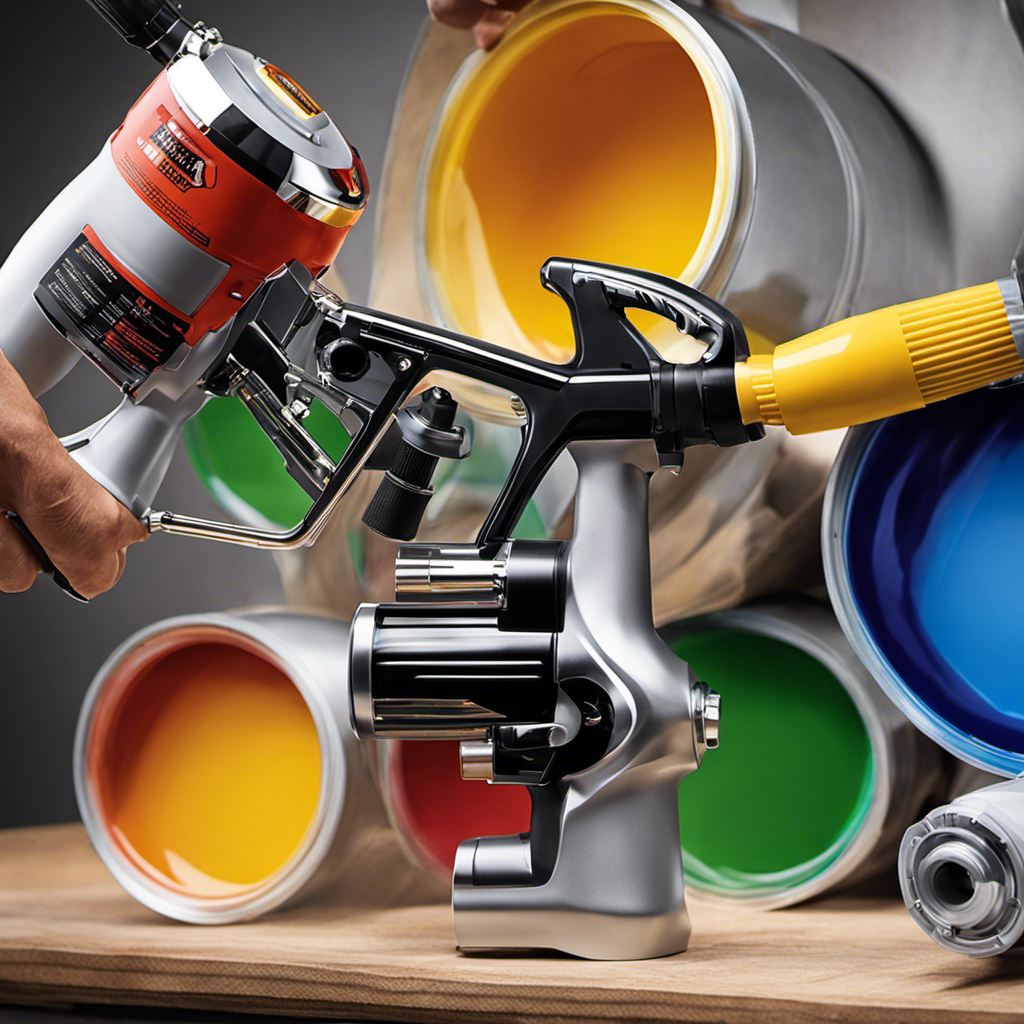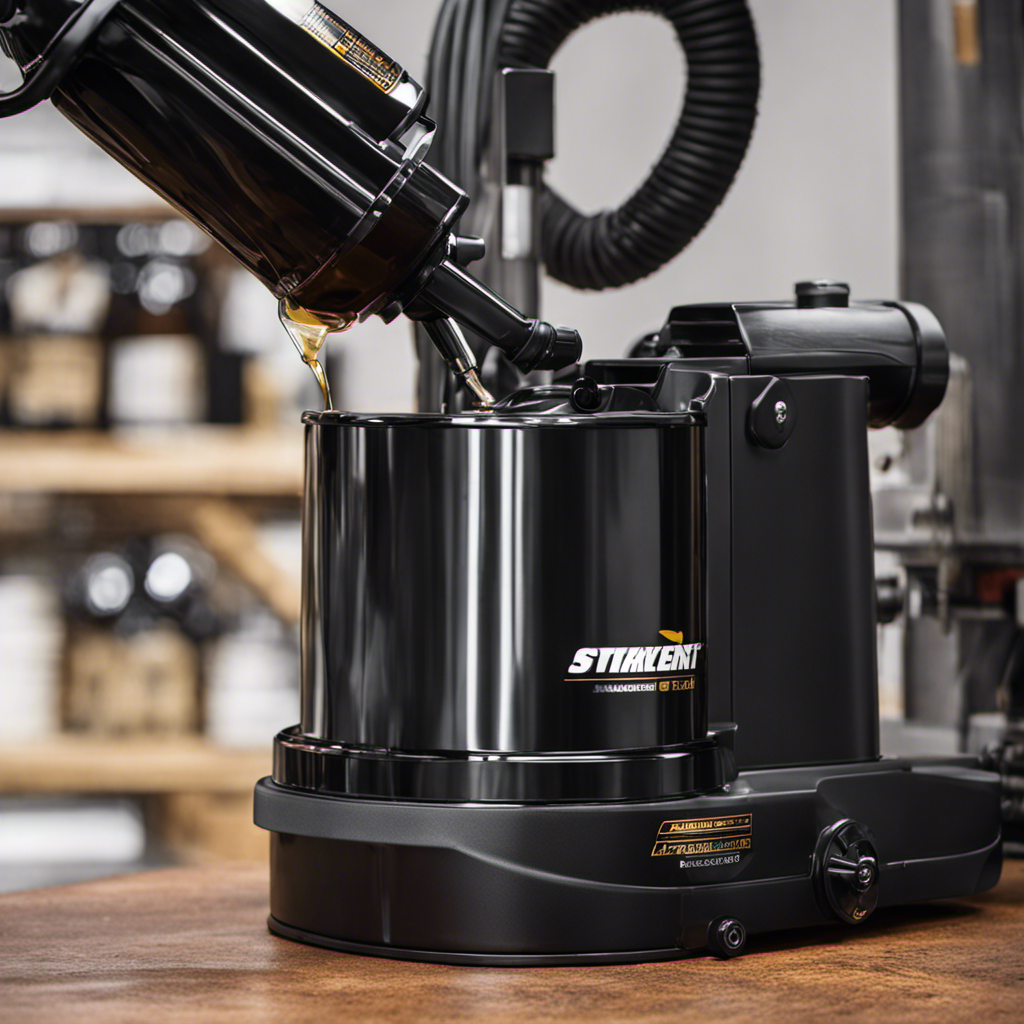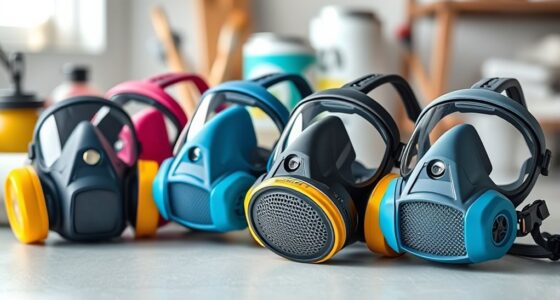In order to achieve perfect, high-quality paint jobs, it is essential to choose the correct nozzle size for your airless paint sprayer. Just like a conductor selecting the right baton size to compose the perfect symphony, painters need to take into account various factors such as the surface area to be painted, the type of paint, the flow rate, and the desired final appearance.
With thicker paints necessitating larger tip sizes and different types of paint requiring specific tip sizes, finding the optimal size is crucial.
So, let’s dive into the world of tip sizes and unlock the secrets to achieving painting perfection.
Key Takeaways
- Tip size should be chosen based on the surface size, type of paint, and desired finish.
- Thicker paints require larger tip sizes, while thinner paints work best with smaller tip sizes.
- Different types of paint require different tip sizes for optimal coverage and finish.
- Consider the surface texture and whether it is smooth or textured when selecting a tip size.
Understanding Tip Sizes
Choosing the right tip size for an airless paint sprayer is crucial. It determines the desired spray fan width and optimal coverage, based on the surface size and type of paint being used.
When it comes to different surface textures, the appropriate tip size should be determined. Smoother surfaces work well with smaller tip sizes, allowing for better control and precision. On the other hand, textured surfaces require larger tip sizes to fill in grooves and uneven areas effectively.
Determining the optimal tip size also depends on project requirements and paint type. Factors such as the desired finish and coverage, as well as the size of the project and the amount of paint needed, should be considered.
Manufacturers have conducted extensive testing and research to determine the best tip size for different projects. It is advisable to consult their guidelines for specialty paints.
Flow Rate Considerations
Considering the flow rate is crucial when selecting a nozzle size for optimal paint coverage and atomization. Flow rate optimization ensures that the paint is delivered at the correct rate, resulting in a smooth and even finish.
Adjusting pressure settings on the airless paint sprayer is also important to achieve the desired results. High pressure can cause overspray and an uneven finish, while low pressure may lead to poor atomization and a low-quality finish.
Tip Size and Paint Thickness
To achieve optimal paint coverage and atomization, one must take into account the thickness of the paint and select an appropriate tip size.
The viscosity of the paint, or its thickness, plays a crucial role in determining the ideal tip size. Thicker paints, such as primers, require larger tip sizes to ensure proper atomization and even coverage. On the other hand, thinner paints like latex or water-based paints work best with smaller tip sizes for better control and precision.
It is important to consult the manufacturers’ guidelines for specialty paints as they may have specific recommendations for tip sizes.
Additionally, adjusting the spray pattern is essential for achieving a professional-looking paint job. By testing and adjusting the pressure setting on the airless paint sprayer, one can achieve a flawless spray pattern and optimal results.
Surface Texture and Desired Finish
Achieving a smooth finish on textured surfaces may require larger tip sizes to fill in grooves and uneven areas. When selecting the right tip size for a glossy finish, there are a few tips to keep in mind.
First, consider the type of surface you are working on. Smooth surfaces generally work well with smaller tip sizes for better control and precision. However, textured surfaces, such as stucco or brick, require larger tip sizes to ensure even coverage and fill in the crevices.
Second, take into account the type of paint you are using. Thinner paints, like latex or water-based paints, typically work best with smaller tip sizes, while thicker paints, such as oil-based paints, require larger tip sizes for better atomization.
Manufacturer Recommendations
The manufacturers’ recommendations for tip sizes are based on extensive testing and research to determine the optimal size for different projects. They understand that choosing the right tip size is crucial for achieving the desired results when using an airless paint sprayer.
Here are some important factors to consider when following the manufacturer recommendations:
-
Paint Type:
-
Different types of paint require different tip sizes for optimal coverage and finish.
-
Consider the viscosity and thickness of primers when selecting a tip size.
-
Latex or water-based paints work well with smaller tip sizes.
-
Oil-based paints require larger tip sizes for better atomization.
-
Consult the manufacturers’ guidelines for specialty paints.
-
Surface Selection:
-
Consider whether the surface is smooth or textured when selecting a tip size.
-
Smooth surfaces work well with smaller tip sizes for better control and precision.
-
Textured surfaces require larger tip sizes to fill in grooves and uneven areas.
-
Take into account whether the surface is vertical or horizontal.
-
Vertical surfaces may require a larger tip size to ensure proper coverage.
-
Project Requirements:
-
Consider the type of surface when selecting a tip size.
-
Determine the desired finish and coverage for the project.
-
Take into account any specific requirements or guidelines provided by the manufacturer.
-
Consider the size of the project and the amount of paint needed.
-
Evaluate any additional factors such as weather conditions or environmental considerations.
Following the manufacturer recommendations for tip sizes will help ensure a successful paint job with an airless paint sprayer.
Tip Sizes for Different Paint Types
Different types of paint work best with specific tip sizes to ensure optimal coverage and finish. When selecting a tip size for your airless paint sprayer, it is important to consider the viscosity and thickness of the paint.
Thicker paints, such as primers, require larger tip sizes for better atomization and to prevent clogging. On the other hand, thinner paints like latex or water-based paints work well with smaller tip sizes for better control and precision.
It is also crucial to adjust the pressure settings on the paint sprayer to achieve a flawless spray pattern and optimal results. High pressure can cause overspray and an uneven finish, while low pressure may result in poor atomization and a low-quality finish.
Considerations for Primers
Consideration should be given to the viscosity and thickness of primers when selecting the appropriate tip size for optimal coverage and finish.
-
Metal Surfaces: When working with metal surfaces, it’s important to choose a tip size that can effectively cover the surface and provide a smooth finish. Metal surfaces often require a thicker primer to ensure proper adhesion and protection against rust and corrosion.
-
Primer Selection: Different types of primers have different viscosities and thicknesses. It’s crucial to select a tip size that is compatible with the specific primer being used. Consult the manufacturer’s guidelines to determine the recommended tip size for the chosen primer.
-
Application: The application method also plays a role in selecting the right tip size. For metal surfaces, it’s recommended to use a larger tip size to accommodate the thicker primer and ensure even application. Adjusting the pressure setting on the airless paint sprayer is also essential to achieve the desired results.
Tip Sizes for Latex or Water-Based Paints
When using latex or water-based paints, it is important to select an appropriate tip size based on the viscosity and desired finish. The proper paint viscosity for latex or water-based paints works well with smaller tip sizes. This ensures better control and precision when spraying on smooth surfaces. However, it is crucial to consider the manufacturer’s guidelines for specialty paints. Thicker paints require larger tip sizes to achieve better atomization and coverage. To emphasize the importance of choosing the right nozzle size, refer to the table below:
| Paint Type | Tip Size Range |
|---|---|
| Latex or Water-based | 0.011 – 0.015 |
| Oil-based | 0.015 – 0.021 |
| Specialty Paints | Consult guidelines |
Tip Sizes for Oil-Based Paints
To achieve better atomization and coverage with oil-based paints, users should select larger tip sizes based on the table provided by the manufacturer. This ensures that the paint is properly dispersed and evenly applied to the surface.
When choosing the right nozzle for oil-based paints, there are several factors to consider:
-
Paint Viscosity: Oil-based paints are typically thicker than water-based paints, so larger tip sizes are needed to accommodate the thicker paint and prevent clogging.
-
Surface Texture: If the surface is textured or rough, a larger tip size will help to fill in the grooves and ensure even coverage.
-
Project Size: The size of the project will also impact the tip size selection. Larger projects may require larger tip sizes to cover a larger area more efficiently.
Specialty Paints and Manufacturer Guidelines
Specialty paints often require specific tip sizes recommended by manufacturers to ensure optimal coverage and a professional-looking finish. These paints, designed for unique applications and effects, may have different viscosity and atomization requirements compared to standard paints. To achieve optimal results, it is important to follow the manufacturer’s guidelines regarding tip size selection.
Here are some tips for achieving optimal results with specialty paints:
-
Consult the manufacturer’s guidelines: Each specialty paint has its own compatibility and application requirements. The manufacturer’s guidelines will provide information on the recommended tip size for the specific paint.
-
Test and adjust: Before starting the project, it is recommended to test the spray pattern and flow rate with the chosen tip size. Adjust the pressure setting on the airless paint sprayer to ensure proper atomization and a flawless spray pattern.
-
Consider the surface texture: Just like with standard paints, the texture of the surface will influence the appropriate tip size. Smoother surfaces generally work well with smaller tip sizes, while textured surfaces may require larger tip sizes to fill in grooves and uneven areas.
-
Follow the manufacturer’s recommendations for paint type: Specialty paints come in various types, such as latex, water-based, or oil-based. Each type may have different viscosity and thickness, which will affect the optimal tip size. Consult the manufacturer’s guidelines for the specific paint type being used.
Tip Sizes for Smooth Surfaces
For achieving a smooth and precise finish on surfaces, smaller tip sizes are ideal.
- Smaller tip sizes allow for better spray pattern control, resulting in more precise application of paint.
- With smaller tip sizes, the paint is evenly distributed and covers the surface more effectively.
- The smaller the tip size, the better the coverage, as the paint particles are atomized into a fine mist that can reach every nook and cranny of the surface.
By using smaller tip sizes, painters can achieve the precision and coverage they desire. It is important to choose the right tip size based on the type of paint being used and the texture of the surface.
Manufacturers have conducted extensive research to determine the optimal tip size for different projects, and following their guidelines can help achieve the best results. Testing and adjusting the spray pattern and flow rate are also crucial for achieving a professional-looking paint job.
Tip Sizes for Textured Surfaces
Texture of the surface plays a crucial role in determining the appropriate tip size for achieving optimal coverage and finish. When dealing with textured surfaces, it is important to select a larger tip size to accommodate the grooves and uneven areas. This will ensure that the paint is able to fill in these areas properly, resulting in a more even coverage.
By using a larger tip size, the paint can be dispersed in a wider spray fan, allowing for better control and coverage. Additionally, adjusting the pressure setting on the airless paint sprayer is essential for achieving a flawless spray pattern and optimal results.
Tip Sizes for Vertical Surfaces
When painting vertical surfaces, it is important to consider the size of the tip to ensure proper coverage and achieve the desired finish.
Testing Methods and Adjusting Techniques:
- Conduct test sprays on a small area to evaluate the coverage and atomization.
- Adjust the pressure setting on the airless paint sprayer to achieve the desired results.
- Gradually increase or decrease the tip size to find the optimal size for the vertical surface.
By using the right tip size, you can achieve even coverage and avoid uneven finishes or overspray. Testing different tip sizes and adjusting the pressure setting will help you find the perfect combination for your project.
Remember to consider the type of paint, surface texture, and desired finish when selecting the tip size. Manufacturers have conducted extensive testing to determine optimal tip sizes for different projects, so consulting their guidelines can provide valuable insights.
Utilizing proper testing methods and adjusting techniques will ensure a professional-looking paint job on vertical surfaces.
Project Requirements and Additional Factors
Considering the size of the project and the amount of paint needed, evaluating any additional factors such as weather conditions or environmental considerations is important when selecting the tip size.
It is crucial to consider how these factors may affect the paint coverage and overall outcome of the project. Environmental factors like temperature and humidity can impact the drying time and adhesion of the paint, so choosing the right tip size can help ensure proper coverage and adherence to the surface.
Evaluating the paint coverage is also essential to achieve the desired results. By selecting the appropriate tip size, one can control the flow rate and spray fan width, allowing for efficient and uniform paint application.
Properly considering these environmental factors and evaluating paint coverage will result in a successful and professional-looking paint job.
Frequently Asked Questions
How Do I Know if I Need a Larger or Smaller Tip Size for My Airless Paint Sprayer?
When determining whether a larger or smaller tip size is needed for an airless paint sprayer, there are several factors to consider. These include the type of paint being used, the surface texture, the desired finish, and any specific project requirements.
Thicker paints typically require larger tip sizes, while thinner paints work best with smaller tip sizes. Additionally, smooth surfaces may benefit from smaller tip sizes for better control, while textured surfaces may require larger tip sizes to fill in grooves and uneven areas.
Can I Use the Same Tip Size for All Types of Paint?
Using different tip sizes for different types of paint is recommended for optimal coverage and finish. It is important to consider the viscosity and thickness of the paint when selecting a tip size.
Smaller tip sizes work well with latex or water-based paints, while oil-based paints require larger tip sizes for better atomization.
Additionally, using a larger tip size for textured paints has the advantage of filling in grooves and uneven areas more effectively.
What Should I Consider When Selecting a Tip Size for Primers?
When selecting a tip size for primers, there are several factors to consider.
The viscosity and thickness of the primer should be taken into account. Generally, thicker primers require larger tip sizes for better atomization.
It is also important to consult the manufacturer’s guidelines for the recommended tip size.
Additionally, the surface texture and desired finish play a role in determining the best tip size for primers.
Are There Any Specific Guidelines for Using Specialty Paints With an Airless Paint Sprayer?
When using specialty paints with an airless paint sprayer, there are specific guidelines to consider. Manufacturers often provide recommendations for tip sizes that are best suited for different types of specialty paints. It’s important to consult these guidelines to ensure optimal coverage and finish.
Additionally, the viscosity and thickness of specialty paints should be taken into account when selecting a tip size. Following these guidelines will help achieve professional results when using specialty paints with an airless paint sprayer.
How Do I Adjust the Pressure Setting on My Airless Paint Sprayer for Optimal Results?
To achieve optimal results with an airless paint sprayer, adjusting the pressure setting is key. By properly adjusting the pressure, you can troubleshoot issues such as overspray or a low-quality finish.
It’s important to find the right balance, as high pressure can cause uneven results while low pressure may result in poor atomization.
Through testing and adjusting the pressure setting, you can achieve a flawless spray pattern and a professional-looking paint job.
Conclusion
In conclusion, choosing the right tip size for your airless paint sprayer is absolutely crucial. It’s like finding the perfect pair of shoes for a marathon – you need the right fit to achieve optimal results.
So, don’t just randomly pick a tip size and hope for the best. Take into consideration factors like surface size, paint type, and desired finish.
And if you’re feeling overwhelmed, don’t worry, manufacturers have got your back with their handy recommendations.
So, go forth and spray, my friend, with the confidence of a seasoned Picasso.
Drenched in creativity and armed with a fountain pen, Isolde weaves words as gracefully as a painter strokes their canvas. A writer for Paint Sprayer Zone, her passion for colors, textures, and spaces finds a harmonious blend with her profound knowledge of painting tools and techniques.
Having grown up in a family of artists, Isolde’s tryst with paints began early. While her relatives expressed themselves on canvas, Isolde found her medium in words. She dedicated herself to chronicling the world of painting, understanding the nuances of each tool, and the artistry behind every spritz of a paint sprayer.










